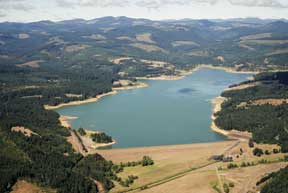Meeting our future water supply needs
by Jeanna Hall, Public Involvement Coordinator, Clean Water Services
The residents and businesses of Washington County need dependable, safe and secure fresh water resources to ensure the long-term economic health and livability of our region. Demand for water in the Tualatin Basin is expected to double by the year 2050, which means the basin will need an additional 50,000 acre feet per year.
 Local water resource agencies in the Tualatin Basin are making efforts to plan now for diverse, safe and reliable water supply sources through the Tualatin Basin Water Supply Project. The partners in the project include Clean Water Services, Tualatin Valley Water District and the cities of Hillsboro and Beaverton in cooperation with the US Bureau of Reclamation. Local water resource agencies in the Tualatin Basin are making efforts to plan now for diverse, safe and reliable water supply sources through the Tualatin Basin Water Supply Project. The partners in the project include Clean Water Services, Tualatin Valley Water District and the cities of Hillsboro and Beaverton in cooperation with the US Bureau of Reclamation.
In 1999, water managers in the Tualatin Basin completed an Integrated Water Resources Management Strategy, a framework for water users and resource managers to meet shared objectives. The conclusion of this effort was to focus on planning for future water supply.
Local water managers formed a partnership in 2001 and funded a Water Supply Feasibility Study (WSFS), a technical evaluation of options to meet water demands through the year 2050.
The WSFS identified a range of water supply options for meeting the future water supply needs in the Tualatin Basin. Several options were recommended for further evaluation including raising Scoggins Dam by 20 or 40 feet, constructing a new dam (Stimson Dam) immediately downstream of the existing dam, and an irrigation exchange pipeline from the Willamette River.
The study also concluded that conservation, reclaimed water, aquifer storage and recovery and planned Portland Bull Run system improvements should be included in any project components. The study was completed in 2004.
The Tualatin Basin Water Supply Project seeks to secure 50,000 acre-feet of needed water to meet growing needs of families, farms, factories and fish.
During 2005, an alternatives analysis examined the various supply options and two were selected for study. A Draft Environmental Impact Statement (EIS) is now being completed to examine the proposed alternatives to meet this need. The two alternative are:
- 40’ Dam Raise Alternative: A proposed 40-foot raise of Scoggins Dam on Hagg Lake with raw water pipeline pumpback (The pump-back increases the reliability of filling a raised Scoggins Dam by pumping winter flows up to Hagg Lake from the pump plant intake.)
- Multiple Source Option Alternative: This includes up to a 25-foot raise of Scoggins Dam, a raw water pipeline pumpback, and the expansion of the Willamette River Water Treatment Plant in Wilsonville.
Both alternatives include conservation targets for homes and businesses, wastewater reuse, and working with farmers to secure in-stream water rights for fish.
The Draft EIS is expected to be published by the US Bureau of Reclamation in Fall 2009.
Water for the Future is a new DVD that illustrates the need, benefits and options that are being studied. The 12-minute video illustrates how local partners are working together to meet long-term needs for drinking water, agricultural irrigation and in-stream flow.
The video will be shown as part of a presentation during the April meeting of CPO1, April 7, 7 pm at St. Vincent Hospital. See cpo1friends.org for details. It can also be seen on Tualatin Valley Community TV or at the project website at www.tualatinbasinwatersupply.org or you can request a copy of the video for your organization or business by contacting Jeanna Hall at 503-681-3619 or hallj@cleanwaterservices.org
|
